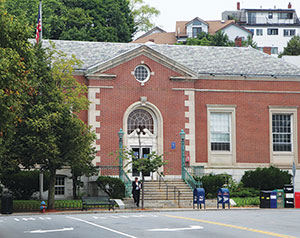
Federal authorities are stepping in to see to it that historically significant post office buildings, such as the one in Union Square, are properly preserved or sold off by the USPS. — Photo by Harry Kane
By Jeremy F. van der Heiden
An advisory council tasked by Congress has released a new report on the legality and scope of the U.S. Postal Services’ (USPS) practices when selling its historic buildings.
Over the past several years, post offices deemed historic have been closed nationwide and sold to various buyers as the USPS works to reconsolidate its assets. In many cities, including Berkeley, California, Winsted, Connecticut and right here in Somerville, officials and residents have raised red flags because of the intrinsic communal value the post offices possess.
In Somerville, that historic value includes the mural in the post office in Union Square, “A Skirmish Between British and Colonists Near Somerville in Revolutionary Times,” completed by artist Ross Moffett in the late 1930s and commissioned under the Works Progress Administration during the Great Depression. The mural holds significant cultural and historic value specifically tied to the city. Moffett, an accomplished artist, has a wealth of work in the Smithsonian American Art Museum, including oil paintings that served as the guide for the mural.
As a result of such concerns and issues nationwide, the Obama administration and Congress put together the Advisory Council on Historic Preservation, which spent the past several months conducting research into the practices of the USPS in its sales of historic buildings. The specific aim of the study was to decide whether the USPS violated Section 106 of the National Historic Preservation Act, which oversees the closure and disposal of historic postal facilities.
Furthermore, the ACHP sought to respond to explanatory statements within the Consolidated Appropriations Act of 2014, Division G.
The Somerville Historic Preservation Commission held a public hearing on the potential sale of the Union Square building back in March to compile statements that would then be forwarded to state officials and, subsequently, the ACHP. The post office closed the beginning of April, and postal services were relocated to a building on Bow Street. The sale status of the Union Square building is unclear.
On the national level, the advisory council ascertained that new public concerns, coupled with the continued efforts of the preservation community, have shown that the federal government must take further action to protect these buildings.
Currently, under Section 106 of the National Historic Preservation Act, the USPS has to conduct a site evaluation to decide whether potential sale sites are listed in the National Register of Historic Places (the building in Union Square has been on the list since 1986), if there are any cultural or historic materials located within, and if any actions taken will hinder the historic value of the building itself or the materials inside. When any of these items come up positive, the USPS is required to conduct public meetings, monitor impacts and create mitigation measures during construction – after obtaining the required permits – while following the various components of Section 106 throughout the process.

Ross Moffett’s mural “A Skirmish Between British and Colonists Near Somerville in Revolutionary Times” embellishes the interior of the now decommissioned Union Square post office.
As for compliance, public notices must be issued that include mitigation plans, the NSHPA Section 106 process initiated and excavation permits acquired.
In the ACHP’s report, which came out in the middle of April, it made several recommendations to Congress, including the suspension of further USPS actions to relocate services out of historic postal facilities and any disposal of the buildings until it implements new guidelines and compliance actions. Officials in the council also suggested the USPS expand and reorganize its historic preservation program, working with the ACHP and other stakeholders to identify opportunities for stronger practices.
The other 12 or so recommendations virtually all tied back into the complete overhaul of the USPS’s practices in selling its historic buildings and items therein, with a specific focus on becoming more proactive in the process of making the strategies more transparent.
The next step, at least on the federal level, will be for Congress to evaluate the information contained within the AHCP’s report and sign several – or all – of these recommendations into law. Recent pressure tests and Congressional hearings have indicated that the majority of officials are motivated to take actions that will further protect historic buildings and force the USPS to become more transparent.
Back in Somerville, the Board of Aldermen’s Legislative Matters Committee brought up this topic at its regular meeting April 21. David Shapiro, assistant city solicitor, as well as Michael Glavin, the director of the Mayor’s Office of Strategic Planning and Community Development, explained to the committee members that they are still in the process of requesting and collecting records from the USPS.
Access to the mural, questions regarding sorting and several other inquiries were included in the city’s request for records from the USPS, and Shapiro explained that he is keeping in correspondence with the branch manager, who will hopefully be appearing for briefings at various meetings.
The aldermen on the committee stated that the matter will be kept on the docket for the next regular meeting, and Shapiro will be attending to disclose any further information discovered through the records request.
More needs to be done on the federal, state and local levels in terms of investigating the USPS’s sale of its buildings. Right now, it seems as though the most common and aggressive pursuit is simply discovering what has been done, whether the steps were taken in compliance with Section 106 of the NHPA, and what actions will be put forth should Somerville or Congress decide that the USPS broke preservation laws.















Reader Comments